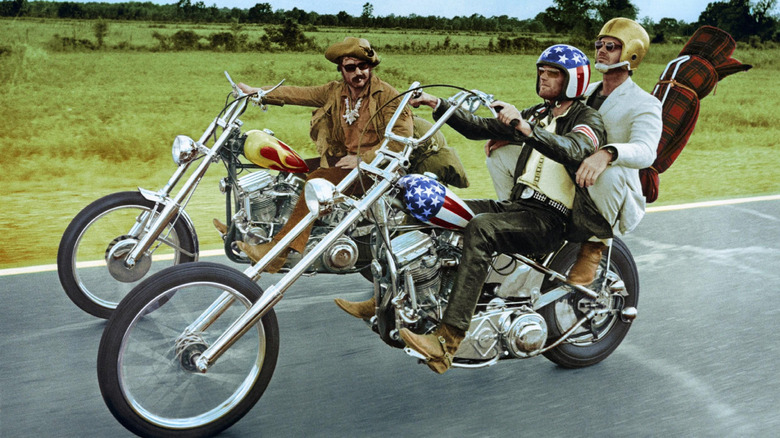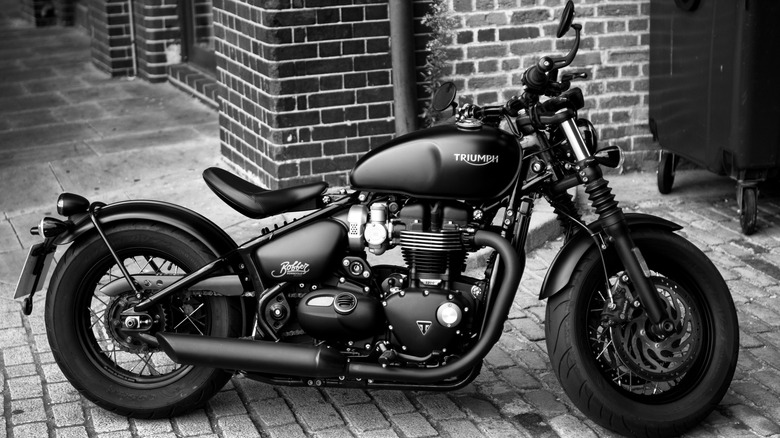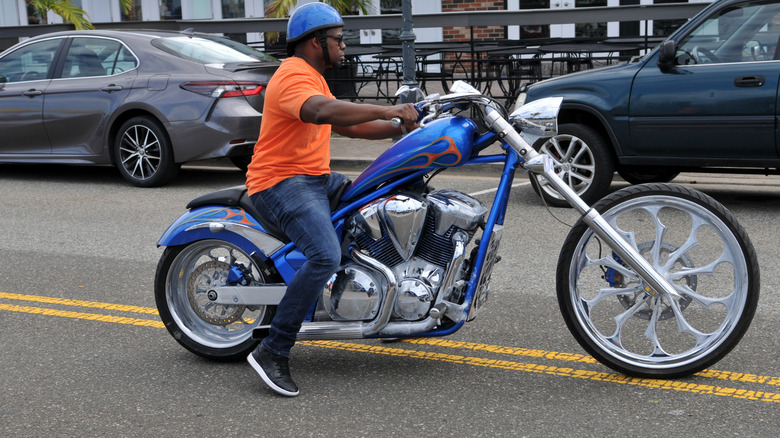What Makes A Motorcycle A Chopper?
Choppers were around before Peter Fonda, Jack Nicholson, and Dennis Hopper starred in the 1969 film "Easy Rider," where Fonda rides the now-famous "Captain America" chopper. The movie, however, most certainly made these custom bikes roar into popular culture. Paul d'Orléans, the world-renowned authority on motorcycle history and culture and author of "The Chopper: The Real Story," said the movie "embodied chopper culture of the 1960s" and made them such a big deal that you had people building them in every part of the world, according to The Vintagent.
Choppers were motorcycles with elongated wheelbases, stretched-out forks, pulled-back ape hanger handlebars, and extreme paint jobs; they were all the rage during the 1960s and into the '70s. Still, they had, for the most part, faded away by the 1980s, only to get resurrected during the early late '90s and early 2000s when the hit Discovery Channel show, "American Chopper," where father and son Teutul at Orange County Choppers spent as much time arguing with each other as they did building bikes.
Modifying motorcycles has been part and parcel of the motorbike scene since this mode of transportation was created. Early inventors like William S. Harley and Arthur Davidson (with Harley-Davidson's first motorcycle) had to initially build them using an assortment of mismatched bicycle parts and small engine components — which is the very definition of "customizing" something. Improving performance was typically the goal, but as the basic building blocks (the engines, suspension, wheels, etc.) became standardized, attention shifted to making their appearance a reflection of the riders.
Bobbers begat choppers
The chopper is a byproduct born from this dynamic transition of form over function. It didn't magically just appear one day in the 1950s. No, they evolved from the motorcycle commonly known as the bobber. Many veterans coming home after World War II became highly skilled mechanics who could easily tear down, fix, and rebuild vehicles. During their time overseas, they had been exposed to the smaller, faster bikes built in Europe, so when they returned stateside, they set their sights on converting the big, bulky Harleys and Indians they had experience with during the war.
Bobbers are basically motorcycles that have been stripped down to their barest essentials and rebuilt with improved speed and performance as much as possible. Even the most powerful Harley Big Twins at the time were pumping out less than 50 horsepower, so reducing 10% of its weight helped considerably. Front fenders were removed and rear fenders were cut short or "bobbed" (removed entirely). Straight pipes replaced exhaust systems, and gas tanks got smaller. Even seat sizes shrank, all in an effort to lighten the bike's overall load.
During the 1950s, the automobile and motorcycle customization scene exploded. Function was again ditched for form, and where only bare essentials were once king, style and "cool factor" took over. Trends from British bike manufacturers made inroads and became more affordable. At the same time, customizers began modifying necks and extending forks until a new breed of bike evolved — enter the chopper.
Choppers got chopped
As forks stretched longer and longer (thus providing more ground clearance), the frame neck had to be tweaked so the bike wouldn't pitch up too far. Each hand-built chopper was unique, but most adhered to a standard set of qualities. For instance, most were hardtail frames with either no rear suspension or very little. They usually had a really high sissy bar on the back seat, a front wheel that was a much different size than the rear, and of course, the ubiquitous raked and/or extended front end.
Where bobbers were built with an emphasis on speed and handling, choppers were constructed for exactly the opposite reasons, preferring to go all style over any practicality. And if you've ever ridden one for any length of time, you know exactly what we're talking about. Choppers reached the height of their popularity in the 1960s and '70s, especially after "Easy Rider" was released. In 1984, Harley-Davidson started building what amounted to a mass-produced chopper with the Softail Custom, but by then were already seeing a decline.
The chopper lost its appeal when it became associated with nefarious types, like biker gangs. Choppers had a resurgence as the calendar flipped from the 1990s into the 2000s with the likes of Jesse James and his West Coast Choppers and the Teutuls with Orange County Chopper, but when the economy tanked in 2008 most custom shops went out of business. However, it has since bounced back and is now thriving.


